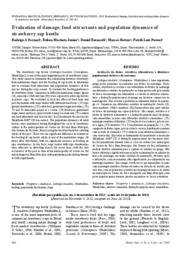Avaliação de danos, atrativos alimentares e dinâmica populacional da broca-do-morango.
Avaliação de danos, atrativos alimentares e dinâmica populacional da broca-do-morango.
Autoria: FORNARI, R. A.; MACHOTA JUNIOR, R.; BERNARDI, D.; BOTTON, M.; PASTORI, P. L.
Resumo: The strawberry sap beetle [Lobiopa insularis (Coleoptera: Nitidulidae)] is one of the most important pests of strawberry crops. This study aimed to determine the relationship between strawberry fruit maturation stages and the feeding of sap beetle in laboratory and to evaluate food attractants and population dynamics of this species during the crop season. To evaluate the feeding preference of strawberry fruits 'Camarosa' at different maturation stages [green (G), semi-ripe (SM) and ripe (R)] were exposed to adult sap beetles in plastic cups. We evaluated in field the effect of food baits and pest fluctuation with traps baited with different food baits: (T1) ripe ground strawberries; (T2) cattle feed, granulated sugar and water; (T3) T1 and T2 attractants mixed at 1:1 ratio; (T4) fruit mix, granulated sugar, water and beer, sprayed with isoamyl-acetate and (T5) control (no food attractants and insecticide). In all treatments the insecticide Malathion1000® CE was mixed. The population dynamics of adult beetles were monitored during throughout the cycle of strawberry culture in the municipalities of Caxias do Sul and Bom Princípio, Rio Grande do Sul state, Brazil, using the best food baits for catching adults of the pest. There was no significant difference in relation to the feeding of sap beetle adults in any of the maturation stages, 96 hours after infestation, with no significant increase in feeding on ripe strawberries. In the field, traps baited with ripe strawberries were effective in attracting insects for seven days, with the first occurrence of the pest in June in the municipality of Caxias do Sul and in August in Bom Princípio, with population peaks during January in both experiments.
Ano de publicação: 2013
Tipo de publicação: Artigo de periódico
Unidade: Embrapa Uva e Vinho
Palavras-chave: Armadilha, Atrativo alimentar, Flutuação Populacional, Fruticultura, Lobiopa Insularis, Morango, Praga de planta
Observações
1 - Por padrão são exibidas publicações dos últimos 20 anos. Para encontrar publicações mais antigas, configure o filtro ano de publicação, colocando o ano a partir do qual você deseja encontrar publicações. O filtro está na coluna da esquerda na busca acima.
2 - Para ler algumas publicações da Embrapa (apenas as que estão em formato ePub), é necessário ter, no celular ou computador, um desses softwares gratuitos. Sistemas Android: Google Play Livros; IOS: iBooks; Windows e Linux: software Calibre.
Acesse outras publicações
Acesse a Base de Dados da Pesquisa Agropecuária (BDPA) para consultar o acervo completo das bibliotecas da Embrapa.

